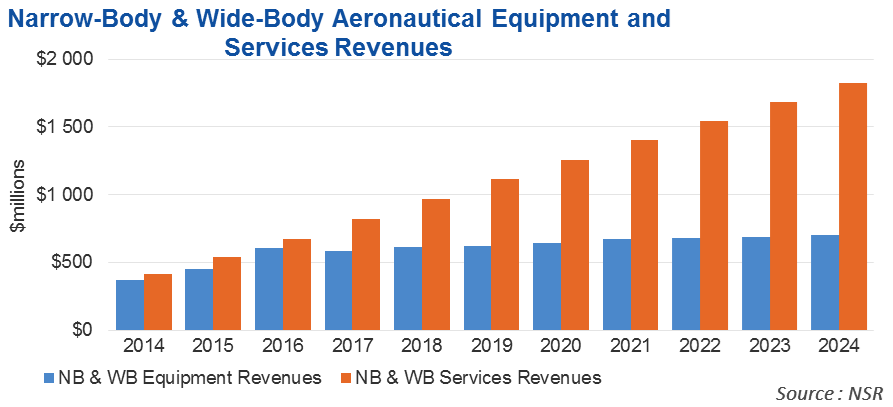In-Flight Connectivity: Are the Puzzle Pieces
Together?
Sep 2nd, 2015 by
Claude Rousseau, NSR
The successful launch of Inmarsat’s 3rd Global
Xpress satellite signals the beginning of a new era for
in-flight connectivity, characterized by a step up in
satellite capacity supply and the advent of global coverage
at speeds not before seen. However, will this mean
that airlines as well as all players along the value-chain
finally reap the benefits that improved technologies bring
to the market? Unfortunately, missing elements along
the IFC value chain don’t permit a resounding ‘Yes!’ to that
question.
In its recent Aeronautical Satcom Markets, 3rd
Edition report, NSR’s revenue forecast from equipment
installed on aircraft of all sizes is still a very large
part of the overall revenues in the short- to medium-term.
But if we take a microscopic view on the two main IFC
markets, wide-body and narrow-body, the difference is even
more stunning. It is not until 2020 that
revenues from satellite-based services to passenger aircraft
will be double that from equipment, and this even
takes into account a strong drop expected in the unit price
of antennas, modems and associated gear needed to bring
connectivity onto the aircraft. In a truly
‘commercial’ satellite market, this ratio would be 10:1 to
be considered healthy.
Technically, solutions today are sufficient for a vast
majority of the market, and improvements such as
metamaterials and low profile gear are expected in the
mid-term that will have a lasting impact on the market.
But will the promise of flat panels break the ROI so much
that airlines will find it a ‘no-brainer’ to give their
passengers free Wi-Fi connections? A few players are
working hard at it from both a GEO (‘FSS’) and LEO or mobile
perspective. However, it is grasping at straws to
believe the business case closes all at once when the form
factor of antennas give airplanes less drag through smaller
size, weight and power.
The cord-cutting of ‘traditional’ VSATs (or bulky radomes)
is years away as certification and OEM deals need to support
the thesis, and these take time. Given all the hoops
that vendors need to go through, is global coverage enough?
The promise that sooner rather than later, connectivity via
satellite will be a solution that reaches (the Holy Grail
of) 100% market penetration rate for both wide-body and
narrow-body (those flying at least over 1.5 to 2 hrs) will
take time to be fulfilled. There
are still roadblocks such as regulation in the U.S. (under
both House and Senate acts and under the FAA ban on cell
phone calls) that steal a bit of the value from the whole
package.

Finally, business-wise, the jury is still out as to what
will be successful: offering airlines a revenue share, or
giving all the controls such that over a certain
‘allotment’, vendors are paid for equipment or services.
Many HTS providers consider that their solutions provide
airlines the most leverage and care less if a certain
threshold is not reached as they are confident in their
ability to get traction across the aircraft population. But
who pays in the end is the customer and for them, the cost
equation is still not sorted out.
Bottom Line
The oncoming jump in capacity with many HTS launching in
the coming years with increasing coverage of promises to
unlock the potential of in-flight connectivity for the
satellite industry. However, there are still many pieces of
the puzzle needed to be in place to realize its potential,
not the least of which involve figuring out a rather complex
and uncertain IFC business model.